Education in the Middle Ages (476 -1300) 1.
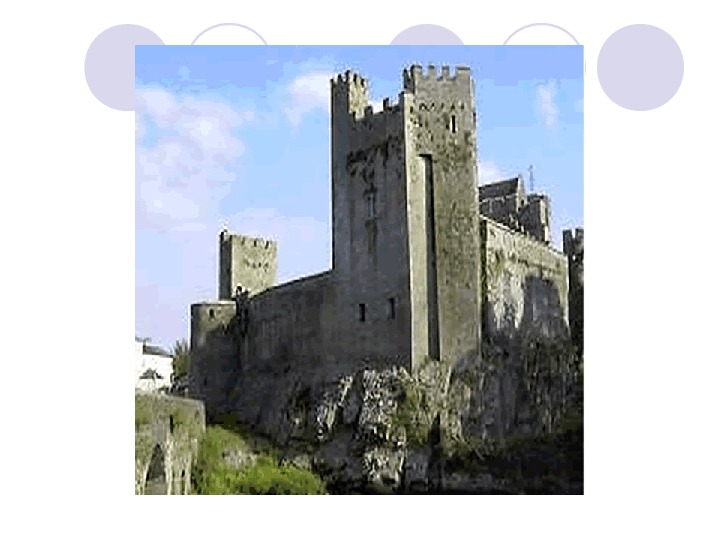
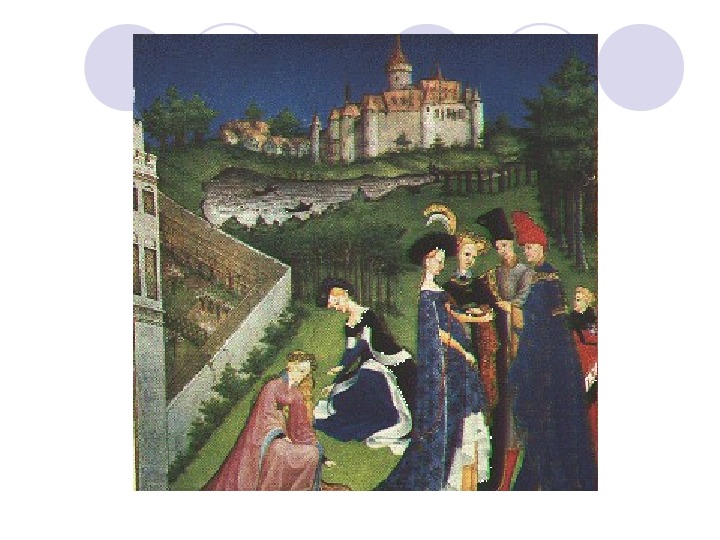
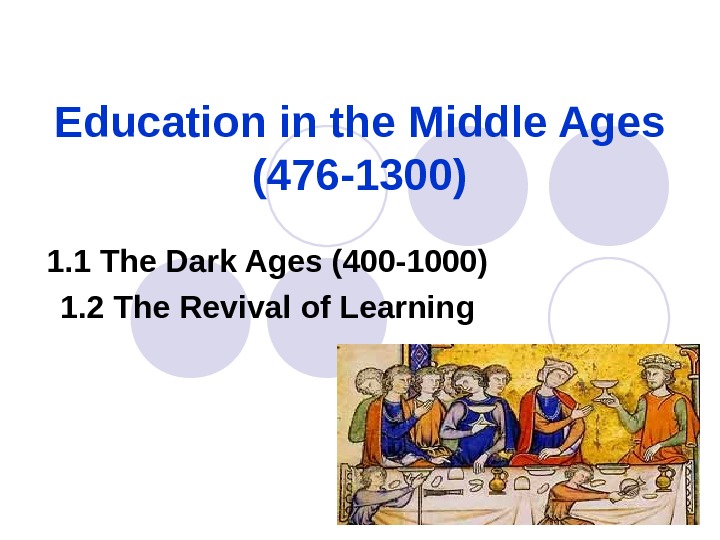
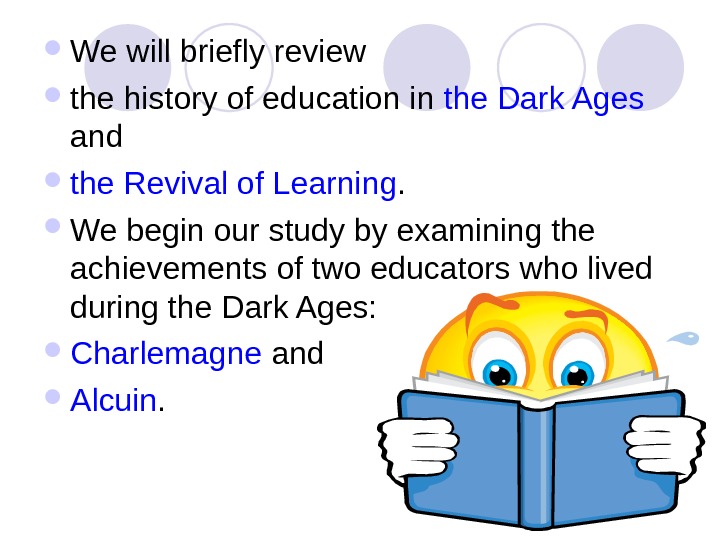
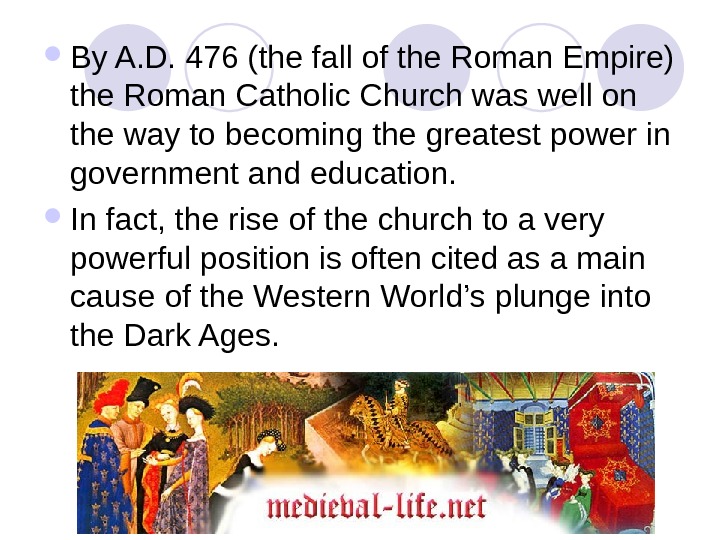

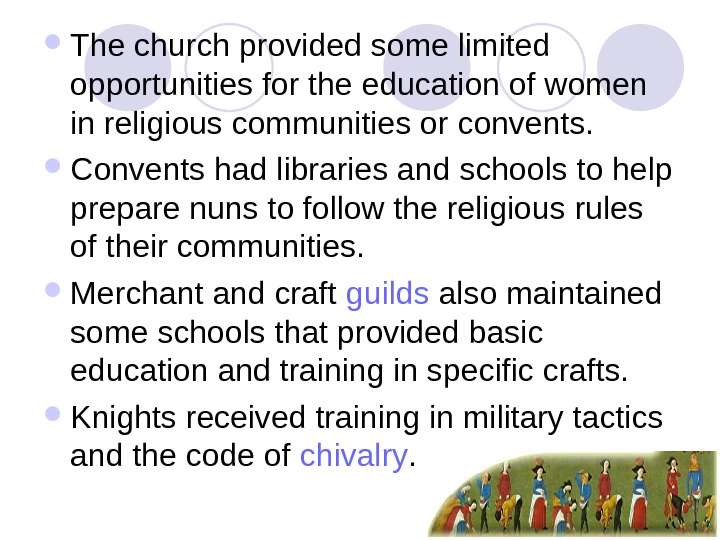
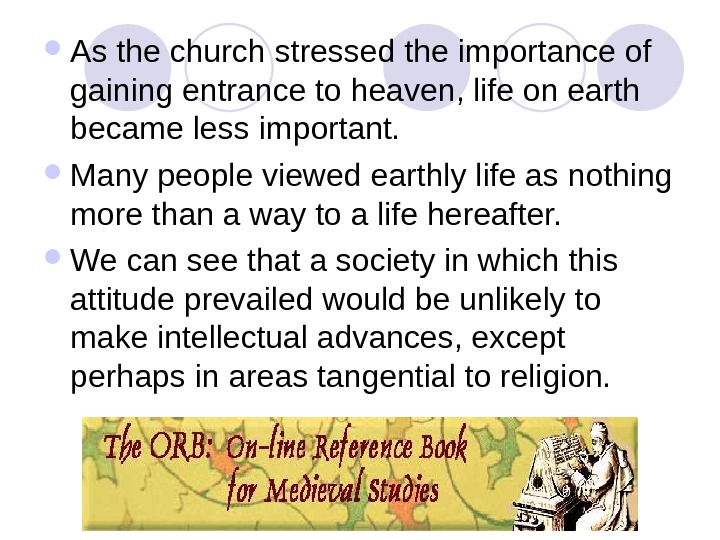
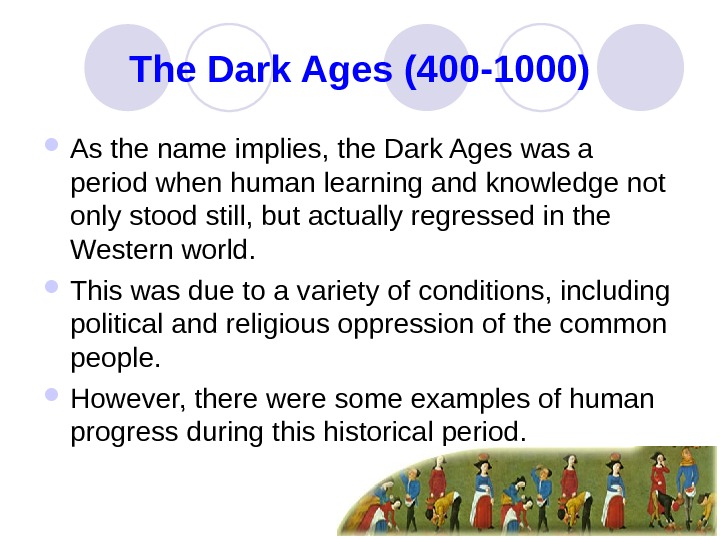
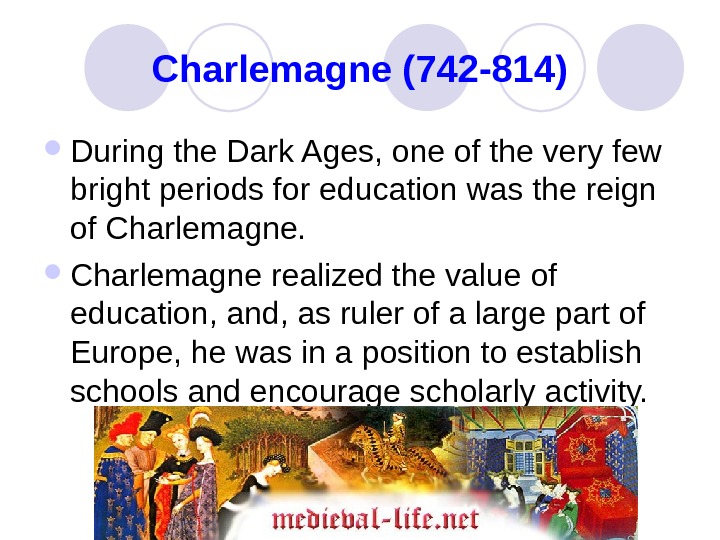
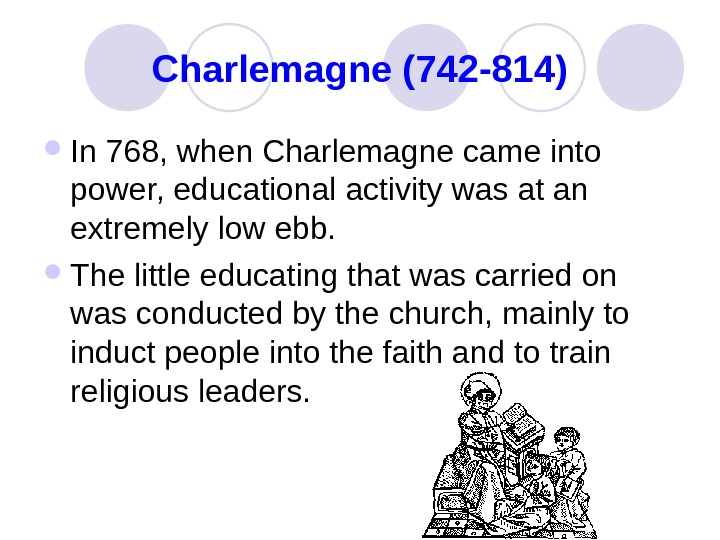
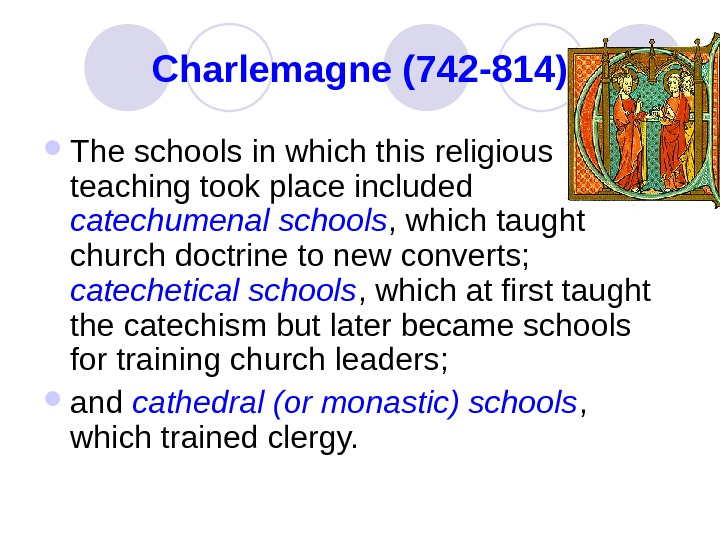

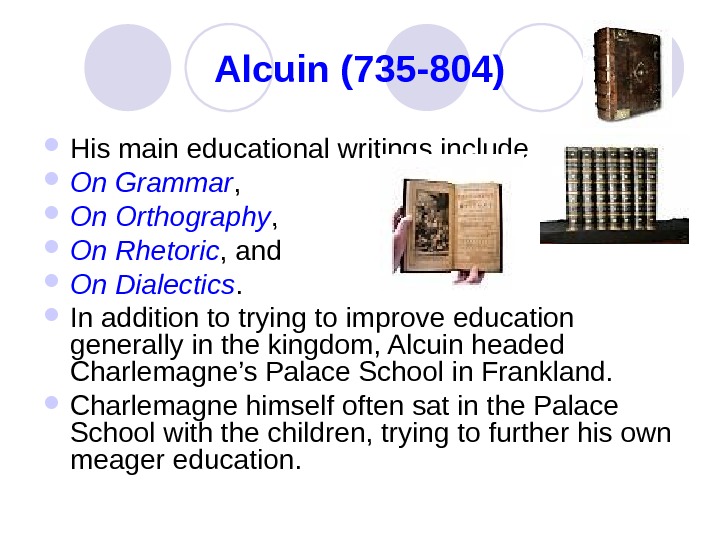
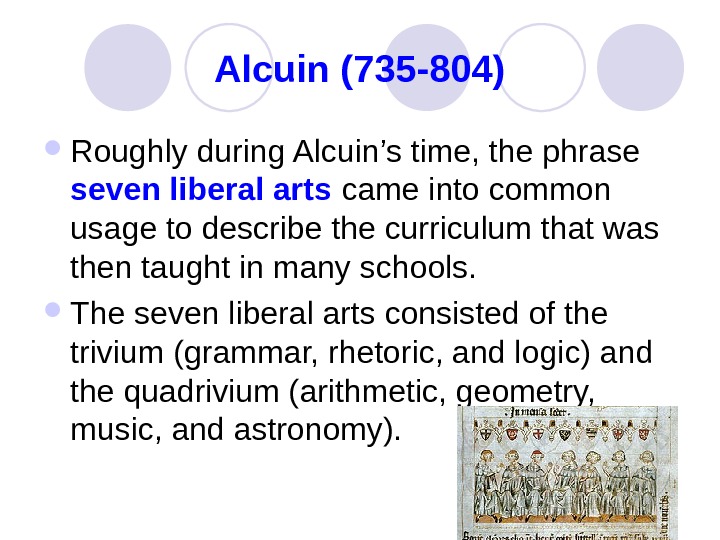
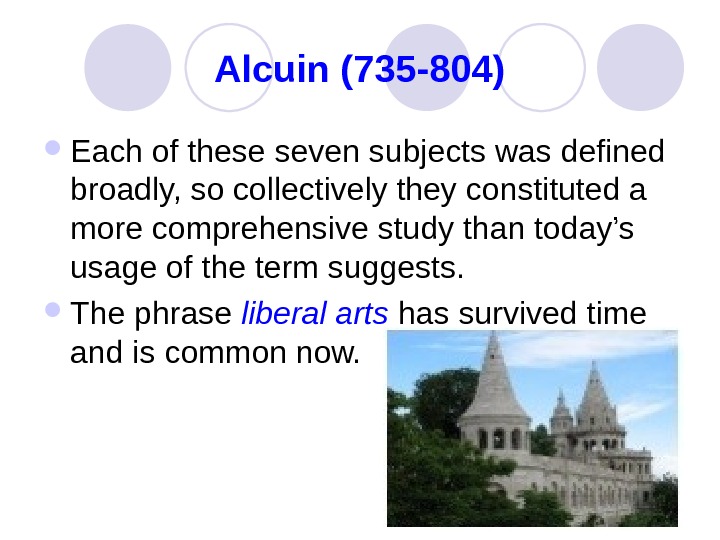
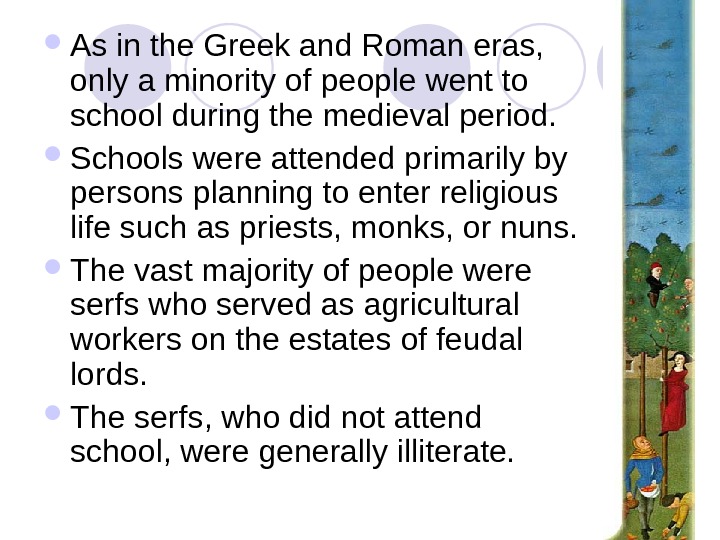
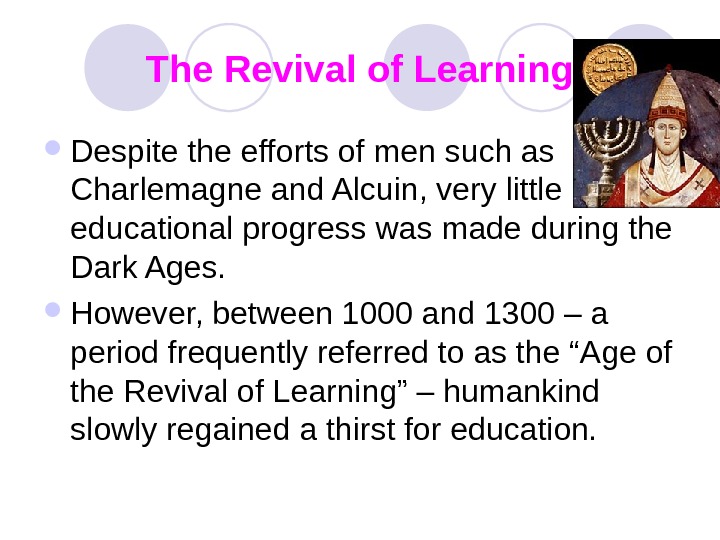
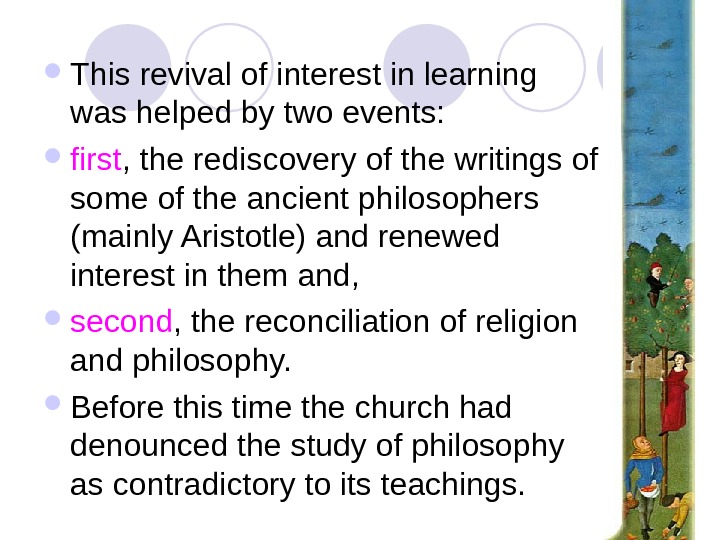
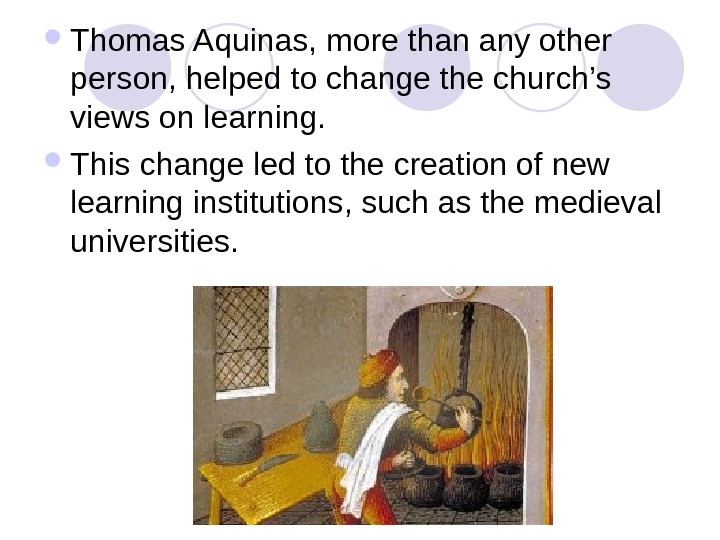
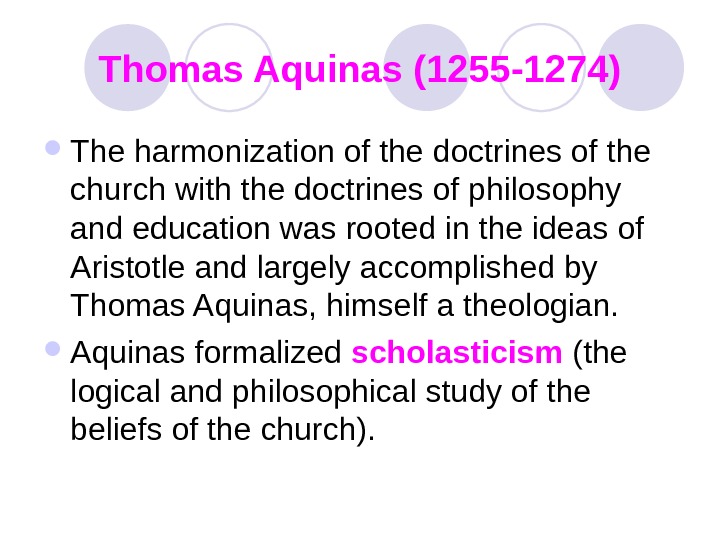
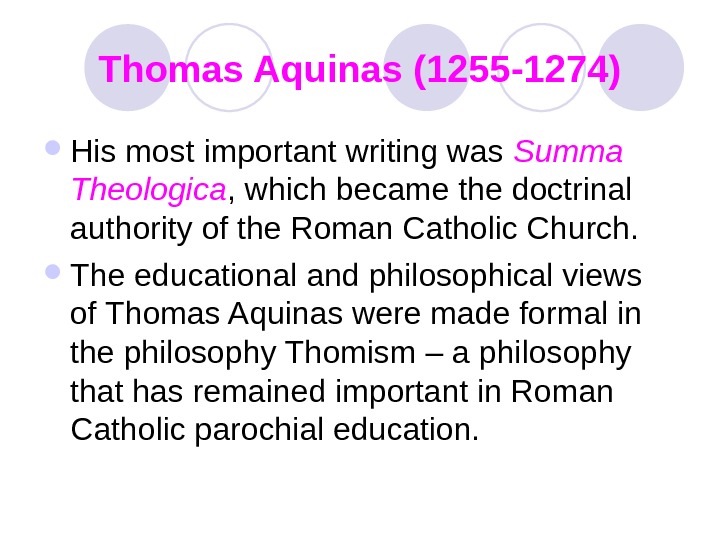
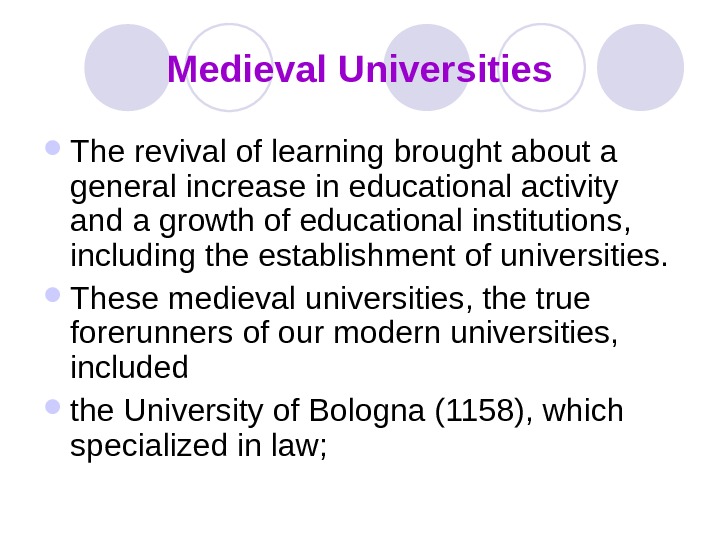
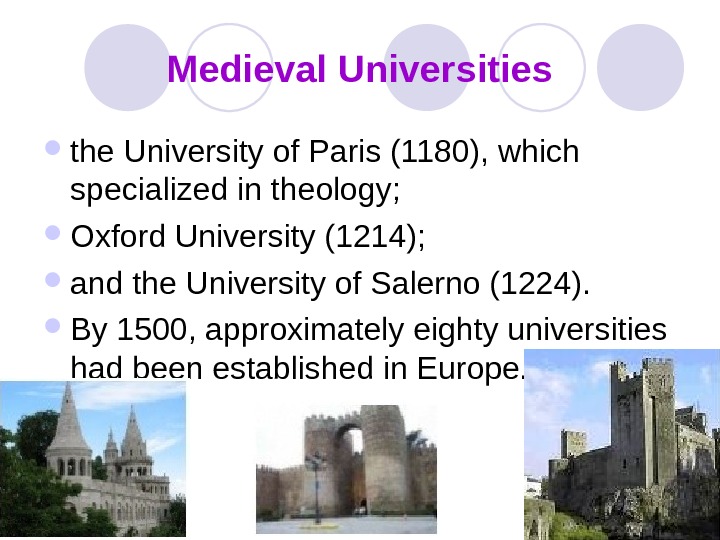
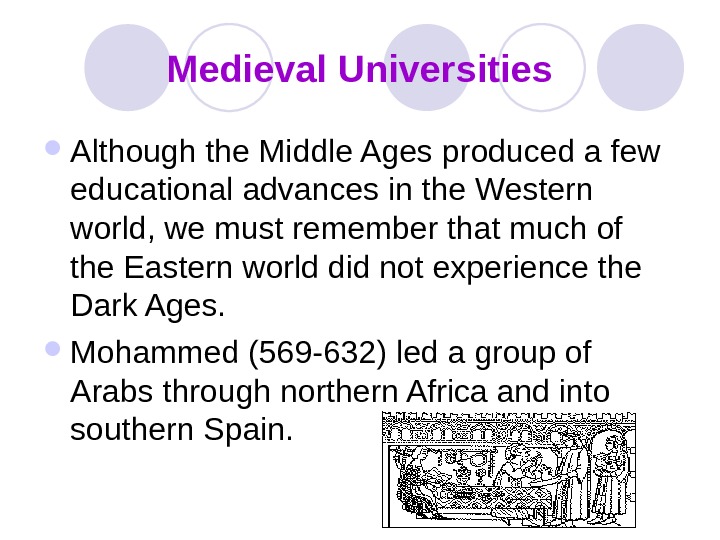
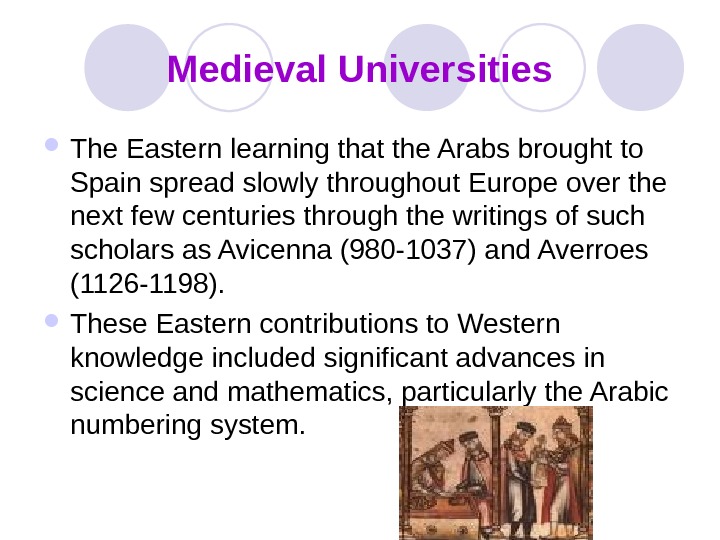
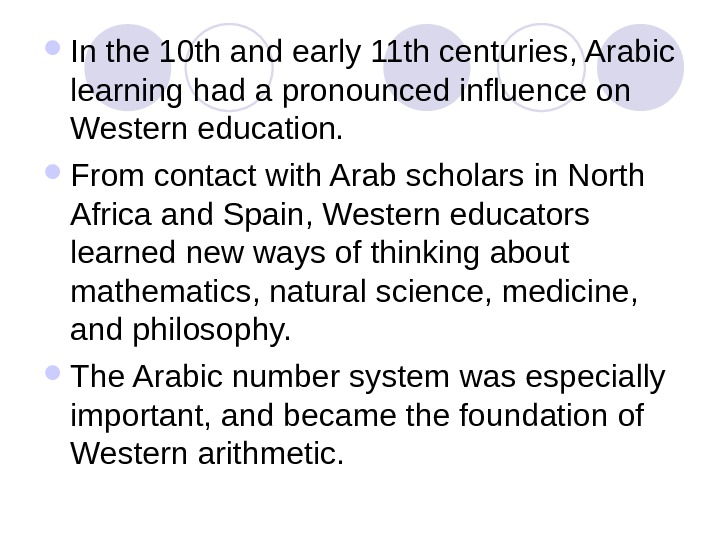
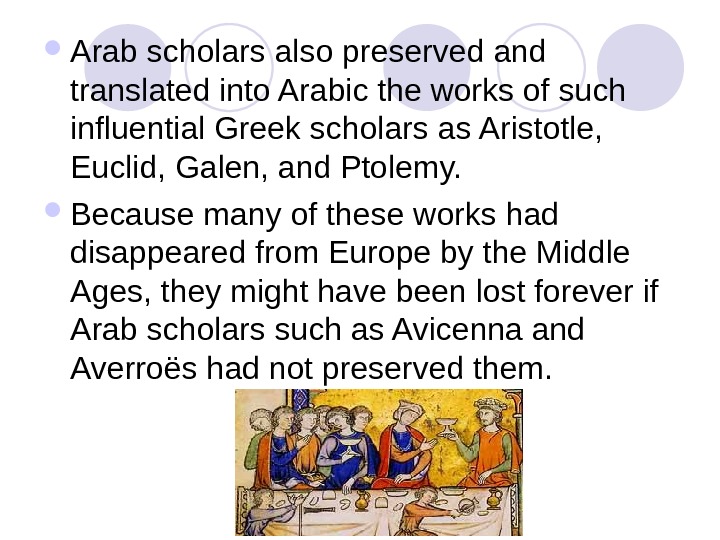
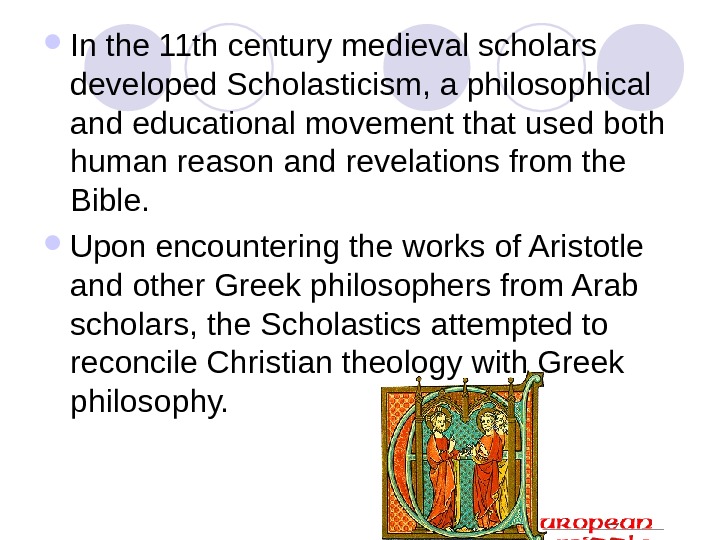
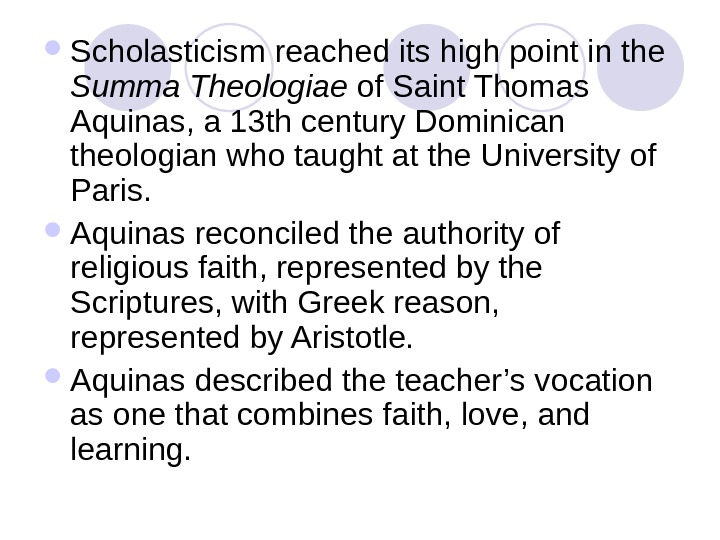
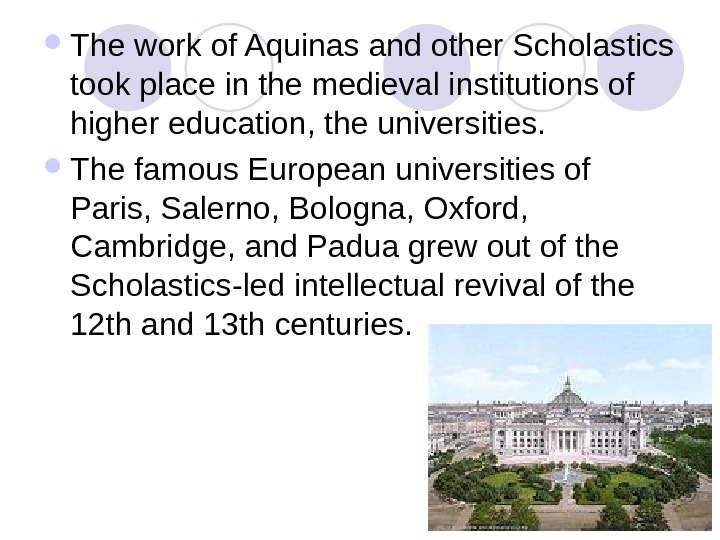
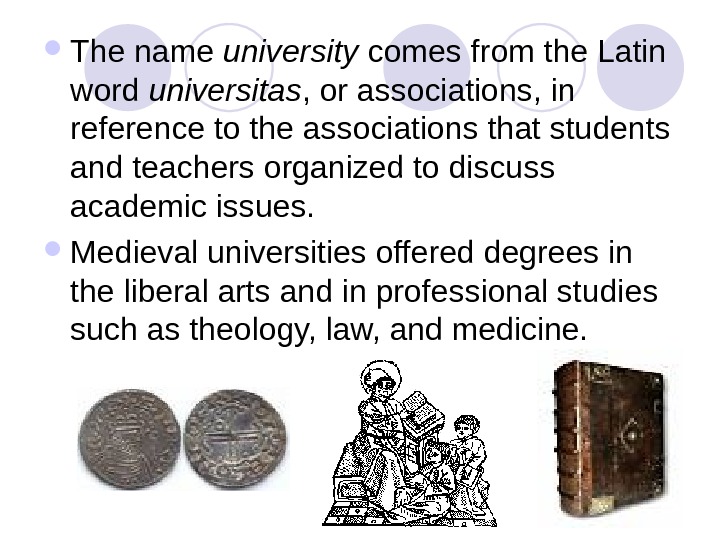
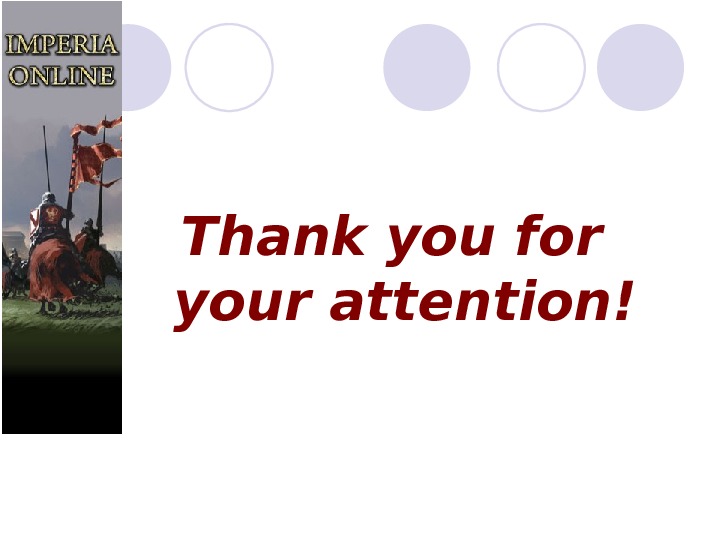
- Размер: 784 Кб
- Количество слайдов: 33
Описание презентации Education in the Middle Ages (476 -1300) 1. по слайдам


 Education in the Middle Ages (476 -1300) 1. 1 The Dark Ages (400 -1000) 1. 2 The Revival of Learning
Education in the Middle Ages (476 -1300) 1. 1 The Dark Ages (400 -1000) 1. 2 The Revival of Learning
 We will briefly review the history of education in the Dark Ages and the Revival of Learning. We begin our study by examining the achievements of two educators who lived during the Dark Ages: Charlemagne and Alcuin.
We will briefly review the history of education in the Dark Ages and the Revival of Learning. We begin our study by examining the achievements of two educators who lived during the Dark Ages: Charlemagne and Alcuin.
 By A. D. 476 (the fall of the Roman Empire) the Roman Catholic Church was well on the way to becoming the greatest power in government and education. In fact, the rise of the church to a very powerful position is often cited as a main cause of the Western World’s plunge into the Dark Ages.
By A. D. 476 (the fall of the Roman Empire) the Roman Catholic Church was well on the way to becoming the greatest power in government and education. In fact, the rise of the church to a very powerful position is often cited as a main cause of the Western World’s plunge into the Dark Ages.
 During the Middle Ages , or the medieval period, which lasted roughly from the 5 th to the 15 th century, Western society and education were heavily shaped by Christianity, particularly the Roman Catholic Church. The Church operated parish, chapel, and monastery schools at the elementary level. Schools in monasteries and cathedrals offered secondary education. Much of the teaching in these schools was directed at learning Latin, the old Roman language used by the church in its ceremonies and teachings.
During the Middle Ages , or the medieval period, which lasted roughly from the 5 th to the 15 th century, Western society and education were heavily shaped by Christianity, particularly the Roman Catholic Church. The Church operated parish, chapel, and monastery schools at the elementary level. Schools in monasteries and cathedrals offered secondary education. Much of the teaching in these schools was directed at learning Latin, the old Roman language used by the church in its ceremonies and teachings.
 The church provided some limited opportunities for the education of women in religious communities or convents. Convents had libraries and schools to help prepare nuns to follow the religious rules of their communities. Merchant and craft guilds also maintained some schools that provided basic education and training in specific crafts. Knights received training in military tactics and the code of chivalry.
The church provided some limited opportunities for the education of women in religious communities or convents. Convents had libraries and schools to help prepare nuns to follow the religious rules of their communities. Merchant and craft guilds also maintained some schools that provided basic education and training in specific crafts. Knights received training in military tactics and the code of chivalry.
 As the church stressed the importance of gaining entrance to heaven, life on earth became less important. Many people viewed earthly life as nothing more than a way to a life hereafter. We can see that a society in which this attitude prevailed would be unlikely to make intellectual advances, except perhaps in areas tangential to religion.
As the church stressed the importance of gaining entrance to heaven, life on earth became less important. Many people viewed earthly life as nothing more than a way to a life hereafter. We can see that a society in which this attitude prevailed would be unlikely to make intellectual advances, except perhaps in areas tangential to religion.
 The Dark Ages (400 -1000) As the name implies, the Dark Ages was a period when human learning and knowledge not only stood still, but actually regressed in the Western world. This was due to a variety of conditions, including political and religious oppression of the common people. However, there were some examples of human progress during this historical period.
The Dark Ages (400 -1000) As the name implies, the Dark Ages was a period when human learning and knowledge not only stood still, but actually regressed in the Western world. This was due to a variety of conditions, including political and religious oppression of the common people. However, there were some examples of human progress during this historical period.
 Charlemagne (742 -814) During the Dark Ages, one of the very few bright periods for education was the reign of Charlemagne realized the value of education, and, as ruler of a large part of Europe, he was in a position to establish schools and encourage scholarly activity.
Charlemagne (742 -814) During the Dark Ages, one of the very few bright periods for education was the reign of Charlemagne realized the value of education, and, as ruler of a large part of Europe, he was in a position to establish schools and encourage scholarly activity.
 Charlemagne (742 -814) In 768, when Charlemagne came into power, educational activity was at an extremely low ebb. The little educating that was carried on was conducted by the church, mainly to induct people into the faith and to train religious leaders.
Charlemagne (742 -814) In 768, when Charlemagne came into power, educational activity was at an extremely low ebb. The little educating that was carried on was conducted by the church, mainly to induct people into the faith and to train religious leaders.
 Charlemagne (742 -814) The schools in which this religious teaching took place included catechumenal schools , which taught church doctrine to new converts; catechetical schools , which at first taught the catechism but later became schools for training church leaders; and cathedral (or monastic) schools , which trained clergy.
Charlemagne (742 -814) The schools in which this religious teaching took place included catechumenal schools , which taught church doctrine to new converts; catechetical schools , which at first taught the catechism but later became schools for training church leaders; and cathedral (or monastic) schools , which trained clergy.
 Alcuin (735 -804) Charlemagne sought far and wide for a talented educator who could improve education in the kingdom, finally selecting Alcuin, who had been a teacher in England. While Alcuin served as Charlemagne’s chief educational advisor, he became the most famous educator of his day.
Alcuin (735 -804) Charlemagne sought far and wide for a talented educator who could improve education in the kingdom, finally selecting Alcuin, who had been a teacher in England. While Alcuin served as Charlemagne’s chief educational advisor, he became the most famous educator of his day.
 Alcuin (735 -804) His main educational writings include On Grammar , On Orthography , On Rhetoric , and On Dialectics. In addition to trying to improve education generally in the kingdom, Alcuin headed Charlemagne’s Palace School in Frankland. Charlemagne himself often sat in the Palace School with the children, trying to further his own meager education.
Alcuin (735 -804) His main educational writings include On Grammar , On Orthography , On Rhetoric , and On Dialectics. In addition to trying to improve education generally in the kingdom, Alcuin headed Charlemagne’s Palace School in Frankland. Charlemagne himself often sat in the Palace School with the children, trying to further his own meager education.
 Alcuin (735 -804) Roughly during Alcuin’s time, the phrase seven liberal arts came into common usage to describe the curriculum that was then taught in many schools. The seven liberal arts consisted of the trivium (grammar, rhetoric, and logic) and the quadrivium (arithmetic, geometry, music, and astronomy).
Alcuin (735 -804) Roughly during Alcuin’s time, the phrase seven liberal arts came into common usage to describe the curriculum that was then taught in many schools. The seven liberal arts consisted of the trivium (grammar, rhetoric, and logic) and the quadrivium (arithmetic, geometry, music, and astronomy).
 Alcuin (735 -804) Each of these seven subjects was defined broadly, so collectively they constituted a more comprehensive study than today’s usage of the term suggests. The phrase liberal arts has survived time and is common now.
Alcuin (735 -804) Each of these seven subjects was defined broadly, so collectively they constituted a more comprehensive study than today’s usage of the term suggests. The phrase liberal arts has survived time and is common now.
 As in the Greek and Roman eras, only a minority of people went to school during the medieval period. Schools were attended primarily by persons planning to enter religious life such as priests, monks, or nuns. The vast majority of people were serfs who served as agricultural workers on the estates of feudal lords. The serfs, who did not attend school, were generally illiterate.
As in the Greek and Roman eras, only a minority of people went to school during the medieval period. Schools were attended primarily by persons planning to enter religious life such as priests, monks, or nuns. The vast majority of people were serfs who served as agricultural workers on the estates of feudal lords. The serfs, who did not attend school, were generally illiterate.
 The Revival of Learning Despite the efforts of men such as Charlemagne and Alcuin, very little educational progress was made during the Dark Ages. However, between 1000 and 1300 – a period frequently referred to as the “Age of the Revival of Learning” – humankind slowly regained a thirst for education.
The Revival of Learning Despite the efforts of men such as Charlemagne and Alcuin, very little educational progress was made during the Dark Ages. However, between 1000 and 1300 – a period frequently referred to as the “Age of the Revival of Learning” – humankind slowly regained a thirst for education.
 This revival of interest in learning was helped by two events: first , the rediscovery of the writings of some of the ancient philosophers (mainly Aristotle) and renewed interest in them and, second , the reconciliation of religion and philosophy. Before this time the church had denounced the study of philosophy as contradictory to its teachings.
This revival of interest in learning was helped by two events: first , the rediscovery of the writings of some of the ancient philosophers (mainly Aristotle) and renewed interest in them and, second , the reconciliation of religion and philosophy. Before this time the church had denounced the study of philosophy as contradictory to its teachings.
 Thomas Aquinas, more than any other person, helped to change the church’s views on learning. This change led to the creation of new learning institutions, such as the medieval universities.
Thomas Aquinas, more than any other person, helped to change the church’s views on learning. This change led to the creation of new learning institutions, such as the medieval universities.
 Thomas Aquinas (1255 -1274) The harmonization of the doctrines of the church with the doctrines of philosophy and education was rooted in the ideas of Aristotle and largely accomplished by Thomas Aquinas, himself a theologian. Aquinas formalized scholasticism (the logical and philosophical study of the beliefs of the church).
Thomas Aquinas (1255 -1274) The harmonization of the doctrines of the church with the doctrines of philosophy and education was rooted in the ideas of Aristotle and largely accomplished by Thomas Aquinas, himself a theologian. Aquinas formalized scholasticism (the logical and philosophical study of the beliefs of the church).
 Thomas Aquinas (1255 -1274) His most important writing was Summa Theologica , which became the doctrinal authority of the Roman Catholic Church. The educational and philosophical views of Thomas Aquinas were made formal in the philosophy Thomism – a philosophy that has remained important in Roman Catholic parochial education.
Thomas Aquinas (1255 -1274) His most important writing was Summa Theologica , which became the doctrinal authority of the Roman Catholic Church. The educational and philosophical views of Thomas Aquinas were made formal in the philosophy Thomism – a philosophy that has remained important in Roman Catholic parochial education.
 Medieval Universities The revival of learning brought about a general increase in educational activity and a growth of educational institutions, including the establishment of universities. These medieval universities, the true forerunners of our modern universities, included the University of Bologna (1158), which specialized in law;
Medieval Universities The revival of learning brought about a general increase in educational activity and a growth of educational institutions, including the establishment of universities. These medieval universities, the true forerunners of our modern universities, included the University of Bologna (1158), which specialized in law;
 Medieval Universities the University of Paris (1180), which specialized in theology; Oxford University (1214); and the University of Salerno (1224). By 1500, approximately eighty universities had been established in Europe.
Medieval Universities the University of Paris (1180), which specialized in theology; Oxford University (1214); and the University of Salerno (1224). By 1500, approximately eighty universities had been established in Europe.
 Medieval Universities Although the Middle Ages produced a few educational advances in the Western world, we must remember that much of the Eastern world did not experience the Dark Ages. Mohammed (569 -632) led a group of Arabs through northern Africa and into southern Spain.
Medieval Universities Although the Middle Ages produced a few educational advances in the Western world, we must remember that much of the Eastern world did not experience the Dark Ages. Mohammed (569 -632) led a group of Arabs through northern Africa and into southern Spain.
 Medieval Universities The Eastern learning that the Arabs brought to Spain spread slowly throughout Europe over the next few centuries through the writings of such scholars as Avicenna (980 -1037) and Averroes (1126 -1198). These Eastern contributions to Western knowledge included significant advances in science and mathematics, particularly the Arabic numbering system.
Medieval Universities The Eastern learning that the Arabs brought to Spain spread slowly throughout Europe over the next few centuries through the writings of such scholars as Avicenna (980 -1037) and Averroes (1126 -1198). These Eastern contributions to Western knowledge included significant advances in science and mathematics, particularly the Arabic numbering system.
 In the 10 th and early 11 th centuries, Arabic learning had a pronounced influence on Western education. From contact with Arab scholars in North Africa and Spain, Western educators learned new ways of thinking about mathematics, natural science, medicine, and philosophy. The Arabic number system was especially important, and became the foundation of Western arithmetic.
In the 10 th and early 11 th centuries, Arabic learning had a pronounced influence on Western education. From contact with Arab scholars in North Africa and Spain, Western educators learned new ways of thinking about mathematics, natural science, medicine, and philosophy. The Arabic number system was especially important, and became the foundation of Western arithmetic.
 Arab scholars also preserved and translated into Arabic the works of such influential Greek scholars as Aristotle, Euclid, Galen, and Ptolemy. Because many of these works had disappeared from Europe by the Middle Ages, they might have been lost forever if Arab scholars such as Avicenna and Averroës had not preserved them.
Arab scholars also preserved and translated into Arabic the works of such influential Greek scholars as Aristotle, Euclid, Galen, and Ptolemy. Because many of these works had disappeared from Europe by the Middle Ages, they might have been lost forever if Arab scholars such as Avicenna and Averroës had not preserved them.
 In the 11 th century medieval scholars developed Scholasticism, a philosophical and educational movement that used both human reason and revelations from the Bible. Upon encountering the works of Aristotle and other Greek philosophers from Arab scholars, the Scholastics attempted to reconcile Christian theology with Greek philosophy.
In the 11 th century medieval scholars developed Scholasticism, a philosophical and educational movement that used both human reason and revelations from the Bible. Upon encountering the works of Aristotle and other Greek philosophers from Arab scholars, the Scholastics attempted to reconcile Christian theology with Greek philosophy.
 Scholasticism reached its high point in the Summa Theologiae of Saint Thomas Aquinas, a 13 th century Dominican theologian who taught at the University of Paris. Aquinas reconciled the authority of religious faith, represented by the Scriptures, with Greek reason, represented by Aristotle. Aquinas described the teacher’s vocation as one that combines faith, love, and learning.
Scholasticism reached its high point in the Summa Theologiae of Saint Thomas Aquinas, a 13 th century Dominican theologian who taught at the University of Paris. Aquinas reconciled the authority of religious faith, represented by the Scriptures, with Greek reason, represented by Aristotle. Aquinas described the teacher’s vocation as one that combines faith, love, and learning.
 The work of Aquinas and other Scholastics took place in the medieval institutions of higher education, the universities. The famous European universities of Paris, Salerno, Bologna, Oxford, Cambridge, and Padua grew out of the Scholastics-led intellectual revival of the 12 th and 13 th centuries.
The work of Aquinas and other Scholastics took place in the medieval institutions of higher education, the universities. The famous European universities of Paris, Salerno, Bologna, Oxford, Cambridge, and Padua grew out of the Scholastics-led intellectual revival of the 12 th and 13 th centuries.
 The name university comes from the Latin word universitas , or associations, in reference to the associations that students and teachers organized to discuss academic issues. Medieval universities offered degrees in the liberal arts and in professional studies such as theology, law, and medicine.
The name university comes from the Latin word universitas , or associations, in reference to the associations that students and teachers organized to discuss academic issues. Medieval universities offered degrees in the liberal arts and in professional studies such as theology, law, and medicine.
 Thank you for your attention!
Thank you for your attention!
